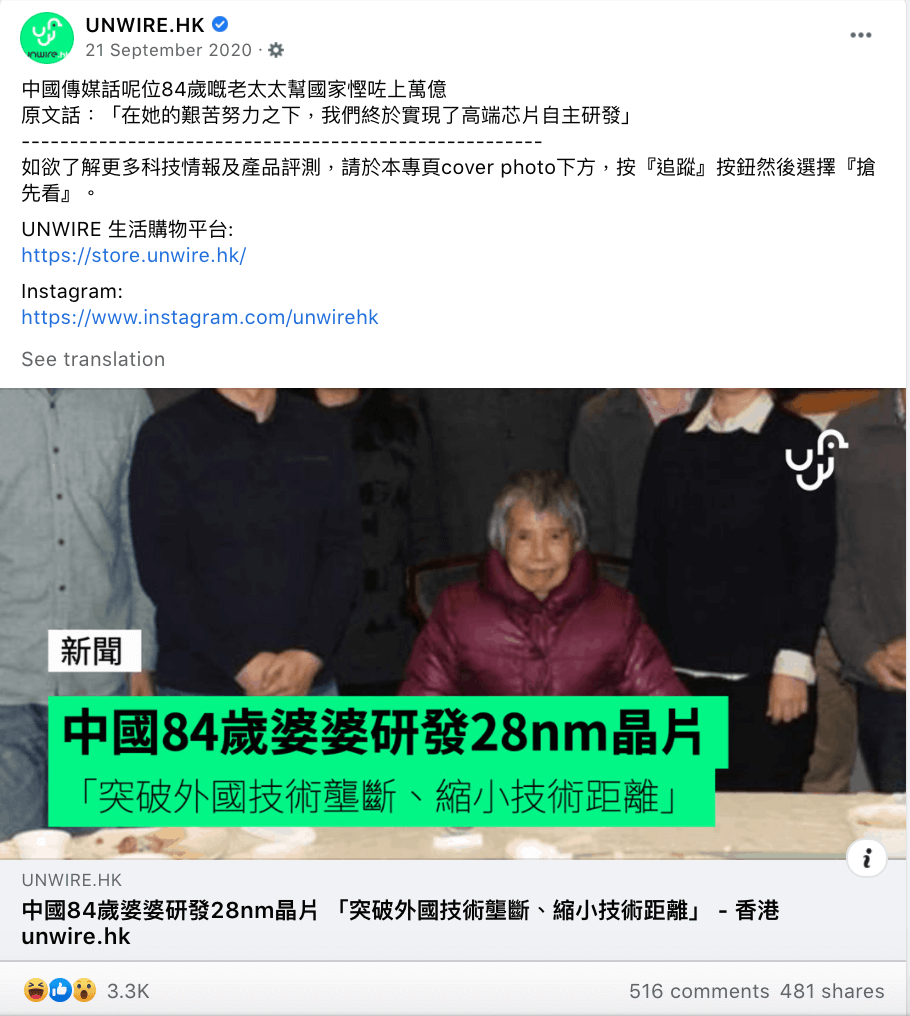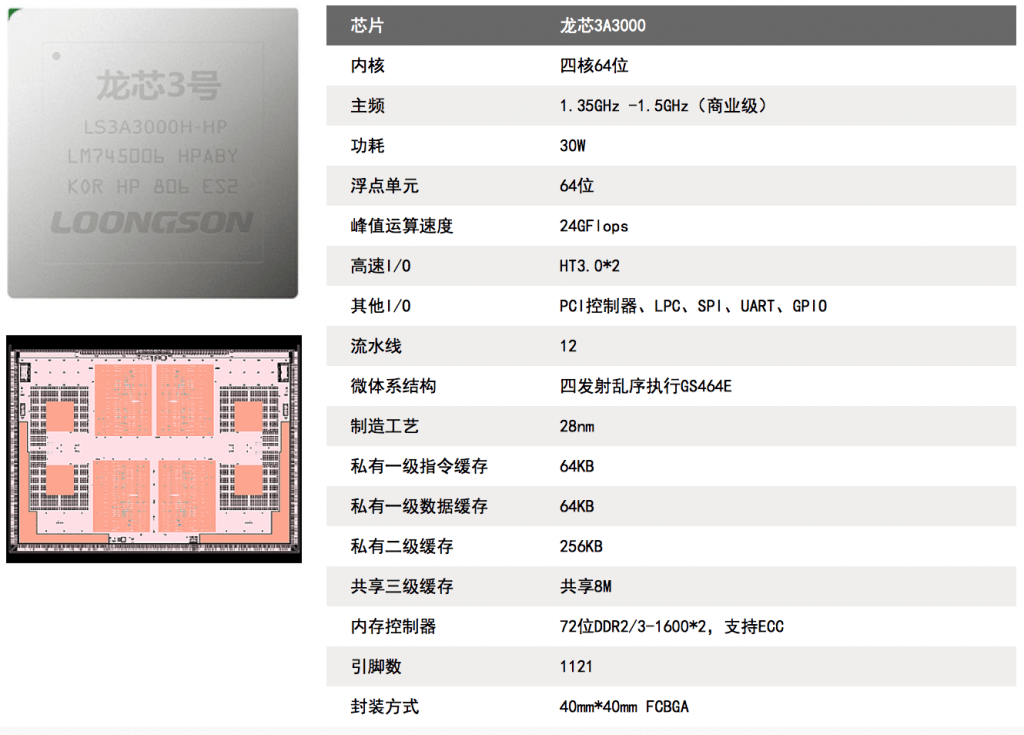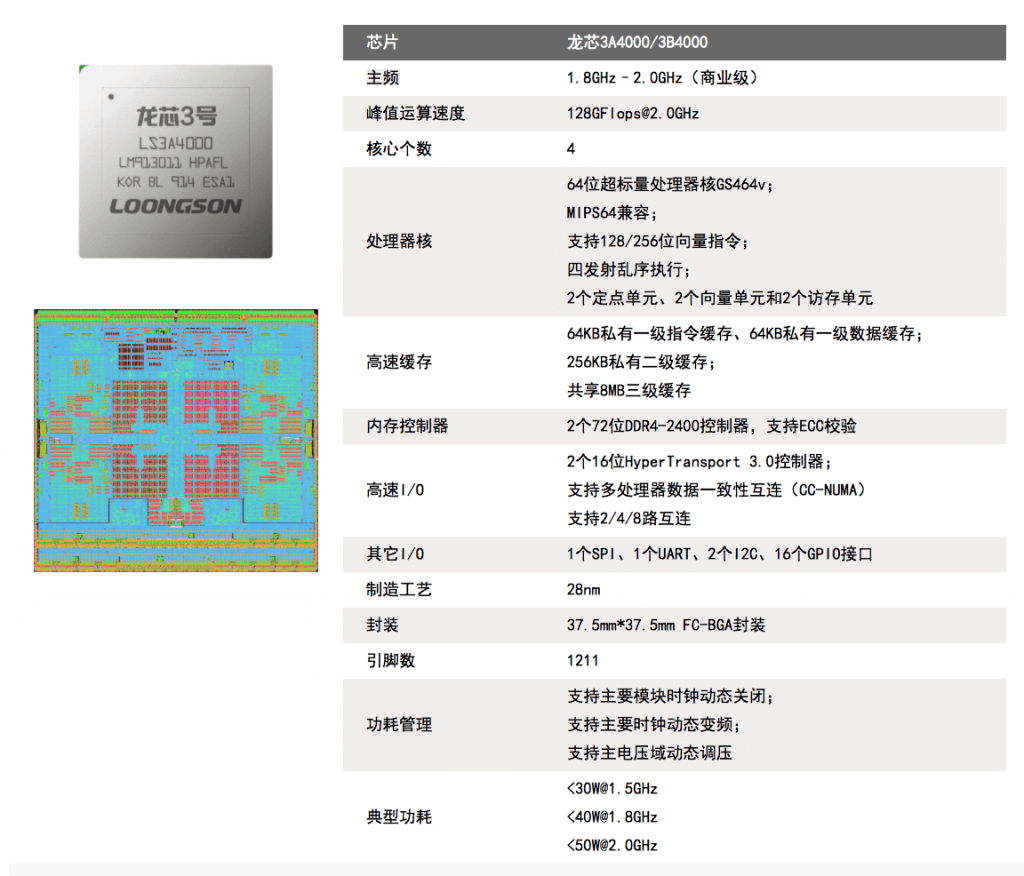Publish Date (HKT) 2020-09-30
[FALSE] Has an 84-year-old granny in mainland China developed a 28nm chip?

A screenshot of the Facebook post
Outline
- Recently, a Facebook page claims that “an 84-year-old granny in mainland China has developed a 28nm chip,” which has aroused doubts among netizens due to the granny’s age.
- According to fact-checking, granny’s name is Huang Lingyi and she is 84 years old. She is a researcher of Loongson Technology Co. Ltd. and joined the R&D team of Loongson chips at the age of 66. She participated in the development of the 28nm chip, however, she did not complete it at the age of 84 and neither was it solely pioneered by her. The development work has been done by a team of which Huang was also a part.
- Therefore, we rate the claim as FALSE.
News Brief
A Hong Kong local website sharing life and tech information—Unwire.hk shared an article on its Facebook page on Sept. 21, 2020. The article said that “The Chinese media reports that this 84-year-old granny helped the country save trillions of dollars with her endeavours. The report reads that ‘with her worthy endeavours, we have achieved the goal of independent research and development of cutting-edge microchips.’” This Facebook post has received 550 comments and 500 shares as of the issuance date of this report. Unwire.hk was established on Jan. 5, 2009, with more than 600,000 people following its Facebook page.
Fact-Checking
The claim questions: Did the 84-year-old granny in mainland China really develop a 28-nanometer chip?
The article is categorized as “technology news” on its website. The source of the article is an original post from Sohu.com, a web portal in China. The post was published on Sept. 14, 2020, by the author named “鐵血大講壇 (Iron Blood Community),” who has been certified by the website as a “quality creator in the military field.”

A screenshot of the article’s source
The article on Unwire.hk points to an 84-year-old Chinese granny, Ms Huang Lingyi, who focuses on the research and development work of semiconductor chips since the 1980s and 1990s. It is alleged that she has independently developed the 28nm CPU chip of the “Loongson 3 series” with her team.
According to the official website of Loongson Technology Co. Ltd., the “Loongson” microchip is the high-performance general-purpose processor series developed by China. “Loongson 3 series” is a product of the “Loongson” chip family created by the company and designed for desktop and server applications. The company currently has two products with the minimum feature size of 28nm, both of which belong to the “Loongson 3 series.” The models of these two products are Loongson 3A3000/3B3000 and Loongson 3A4000. The news articles on the company’s official website, titled “Loongson 2017 new product launching conference, joining hands with partners to build the independent ecology” and “Loongson released the new generation of processors, with every effort to build a new IT industry”, show that Loongson 3A3000/3B3000 was released on April 25, 2017 as the company’s first 28nm chip. The Loongson 3A4000/3B4000 was released on December 24, 2019.

A screenshot of the parameters of Loongson 3A3000/3B3000 processor.

A screenshot of the parameters of Loongson 3A3000/3B3000 processor.
The article on Unwire.hk quoted the post on Sohu.com, showing that the 84-year-old woman, a researcher in Loongson Technology Co. Ltd. responsible for the development of CPU chips, is named Huang Lingyi. According to the article “Witnessing the development of Chinese processors with ages’ endeavours — Congratulations on Ms Huang’s 80th birthday” on the official website of Loongson Technology, published on December 9, 2016, she was born in 1936 and should be 84 years old in 2020. She joined the Institute of Computing Technology, Chinese Academy of Sciences in 1962 and participated in various research projects, including “the first CPU chip designed and developed by China,” and joined Loongson Technology in 2002 (when she was 66 years old). The article reads that “From 1B, 1C to 3A, 3B, then to GS464E, 15 years have passed.” Here, 1B, 1C, 3A, and 3B refer to the chip model whereas GS464E refers to the microarchitecture of the chip.
According to the product information of Loongson Technology, 3A and 3B represent the “Loongson 3 series” microchip, while “GS464E microarchitecture” is currently utilized by “Loongson 3A2000/B2000” and “Loongson 3A3000/3B3000” chips with 40nm and 28 minimum feature sizes respectively.
On the company’s official website, the article “Huang Lingyi, the researcher of Loongson Technology, wins the 2019 CCF XiaPeiSu Award” was published on January 17, 2020. On the website of China Computer Federation (CCF), the article “CCF XiaPeiSu Award—Huang Lingyi, a participant and witness of China’s microelectronics development” was published on February 4, 2020. From the articles mentioned above, Huang Lingyi won the 2019 CCF XiaPeiSu Award as the researcher of Loongson Technology and is still working on the frontline of research and development of microchips with vigour and devotion.
In addition, according to the article “This team has filled the technological gap of CPU microchips in China’s computer industry” on the official website of the company (published on June 27, 2019), the research and development work of the Loongson processors, modelling from the series of Loongson 1 in 2002 to Loongson 3 in 2019, was all done by the entire R&D team of which Ms Hunag Lingyi is a member. The article mentions that “Huang Lingyi is an experienced researcher of the Loongson team, who is still dragging the mouse every day in front of the screen to check the layout in her 80s.”

A screenshot of the article showing Huang was working on the layout of the product.
The information given above shows that the two 28nm Loongson chips were released in 2017 and 2019 (i.e., when Ms Huang Lingyi was 81 and 83 years old respectively) and the Loongson team completed the research and development work, where Huang participated as a team member. The descriptions, such as “84-year-old granny” and “with her worthy endeavours, we have achieved the goal of independent research and development of cutting-edge microchips,” should be rated as misleading information.
Conclusion
According to the fact-checking done above, Ms Huang Lingyi has indeed participated in the research and development work of the 28nm chip. However, this was not completed solely by her at the age of 84. It was done by the entire Loongson team where Ms Huang Lingyi participated as a team member. The claim is misleading, for it might be misinterpreted that the chip is developed solely by her. Therefore, we rate the claim as FALSE.
References
- Facebook post by Unwire.hk
- Report from Unwire.hk website:“A Chinese 84-year-old granny developed 28nm chips, with breakthroughs in the field of foreign monopoly to narrow the technological gap.”
- Report from Sohu.com:“A 84-year-old granny developed microchip for China, saving trillions for the country.”
- The official website of Loongson Technology Co. Ltd.:“Company Introduction”
- Press release from the official website of Loongson Technology Co. Ltd.:“Loongson 2017 new product launching conference, joining hands with partners to build the independent ecology.”
- Press release from the official website of Loongson Technology Co. Ltd.:“Loongson released the new generation of processors, with every effort to build a new IT industry.”
- Press release from the official website of Loongson Technology Co. Ltd.:“Witnessing the development of Chinese processors with ages’ endeavours — Congratulations on Ms Huang Lingyi’s 80th birthday”
- The official website of Loongson Technology Co. Ltd.:“Product Information”
- CCF NEWS-Chinese Computer Federation: “CCF XiaPeiSu Award — Huang Lingyi, a participant and witness to China’s microelectronics development”
- Press release from the official website of Loongson Technology Co. Ltd.:“This team has filled the technological gap of CPU microchips in China’s computer industry.”












 :
:  : 3411 7375
: 3411 7375 :
: